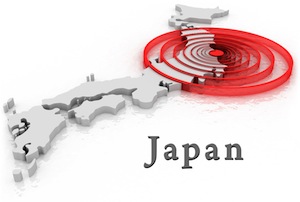Guest Writer for Wake Up World
It’s been nearly three years since the Great East Japan Earthquake of March 11, 2011 but the after-effects continue.
The earthquake and subsequent tsunami killed more than 20,000 men, women and children, devastated areas of northeast Japan, and brought untold horror and misery to many survivors. The core meltdown and release of radioactive material at the Fukushima Daiichi Nuclear Power Plant exacerbated the already apocalyptic situation to a major Level 7 Nuclear disaster, which even led Japan’s Prime Minister to fear for the existence of Japan! [1] And the entire time, authorities have downplayed the impact the radiation had on the environment, despite indications that we’re experiencing a catastrophic nuclear event of epic proportions.
The events at Fukushima will affect every single one of us, and the next 8 facts will provide you with the information necessary to understand and protect yourself.
1. Radiation is Still Going Strong
The radioactive nightmare at Fukushima isn’t over, it’s still going. The initial release of radioactive material went strong for nearly two weeks and radioactive isotopes of iodine, cesium, xenon, krypton, and tellurium spread throughout the atmosphere, soil, and water. [2] TEPCO, the Japanese power company responsible for the Fukushima reactor, finally acknowledged in July 2013 that 300 tons of contaminated water had leaked into the ocean. As recently as December 2013, radioactive material was still leaking from Fukushima!
[pro_ad_display_adzone id=”110028″]
Japanese news outlets indicate radioactive cesium has even been detected in deep groundwater near a reactor. [3] Unfortunately, much of the problem has been inflated because of foolishness. Japan’s Asahi news outlet reported that TEPCO cut costs and used nets made of duct-tape and wire to seal containers containing radioactive water. [4] With such incompetency, it’s certain that the continued release of radioactive material — and higher levels of environmental radiation — will be the new normal.
2. Radiation Has Spread Across the Globe
This year, 2014, a radioactive plume is expected to reach the Pacific coast of the United States. The World Health Organization claims that the radioactive material is too diluted to be dangerous despite the fact that radioactive material will flow for years to come; peaking in 2016. [5] Hey, great, the US Pacific coast will bath in radioactive material for the next 3+ years! This isn’t the only area affected. During the meltdown, radiation was launched into the atmosphere and settled as far away as Slovenia, France, the Canary Islands, and even in the Arctic. [6] [7] [8] [9] [10] [11]
3. Radiation Has Contaminated U.S. Food Supplies
Air, water and milk samples collected across the United States after the Fukushima disaster all showed high levels of radioactive iodine, cesium, and tellurium. [12] Folks, when this stuff hits the globe it spreads like glitter thrown into a fan. There is no safe haven!
4. Water is Affected and Boiling Doesn’t Help
It was once thought that boiling was an effective means for reducing radiation levels in water; this has been found to be false. Tap water with high concentrations of Iodine-131 was found in areas surrounding the Fukushima Power Plant and boiling it did not remove radioactive iodine. In fact, boiling the water resulted in a concentration of the radioactivity due to some of the water boiling off. [13]
5. Survival Tip: Boiling Vegetables Might Reduce Radioactive Contamination
Soil contamination remains a problem in Japan due to the “sprinkling” of radioactive fallout. [14] Recognizing the harm this could cause for food supplies, produce especially, Japanese researchers analyzed and discovered that radioactive material sticks easily to the exterior of vegetables. Leafy vegetables do provide “some” level of relief though as most radioactive material is limited to exterior leaves. Removing them and boiling the inner leaves for 20 minutes has been found to reduce contamination up to 70%. [15] Something to remember when the zombies hit.
6. Pacific Marine Life is Severely Affected
Quickly following the disaster, radioactive isotopes were discovered in marine life including migratory species such as Pacific bluefin tuna. [16] [17] In January 2014, it was reported that fishermen had caught fish that had radiation levels 124 times established standards. [18] Even worse, the ongoing release of contaminated water from the Fukushima Power Plant has caused authorities to warn that fish within 100 miles of the coast likely contain elevated levels of radioactive material.
7. Algae Might Help Solve the Problem
Perhaps the most difficult component to a nuclear event is cleaning up the mess. Now, a newly discovered strain of algae may help decontamination efforts. Parachlorella binos (also known as “Binos”) has demonstrated much potential as a means to neutralize radioactive nucleotides. [19] Compared to other methods of “clean up” which involve chemicals that are almost as hazardous as the radioactive material itself, using algae is a natural strategy for environmental cleanup.
8. Radioactive Iodine Presents the Worst Risk
Immediately following the disaster, Japanese authorities evacuated the area within a 12 mile radius of the power plant due to the outpouring of radioactive material. [20] While a toxic cornucopia of compounds were released, the majority of the concern revolved around exposure to iodine-131 which can cause severe skin damage, thyroid damage, cancer and death. [21] The demand for protective iodine supplements has skyrocketed as a result.
Protect Yourself
When the thyroid is loaded with beneficial iodine, it is less apt to absorb harmful, radioactive iodine-131. In my opinion, every home should have a supply of supplemental iodine and a healthy diet of foods that contain iodine. And, although radioactive material has been found all over the globe, some areas are worse than others. Be mindful of where you’re traveling (or living) and most importantly, be mindful of where your food comes from!
What measures have you taken? Please leave a comment below and share your tips with us!
-Dr. Edward F. Group III, DC, ND, DACBN, DCBCN, DABFM
Editor’s note: Stay tuned for Dr. Group’s next article on Wake Up World, “13 Natural Remedies For Radiation Exposure”, on Wednesday 26th February.
References:
- Fitzgerald J, Wollner SB, Adalja AA, Morhard R, Cicero A, Inglesby TV. Biosecur Bioterror. After Fukushima: managing the consequences of a radiological release. Biosecur Bioterror. 2012 Jun;10(2):228-36. doi: 10.1089/bsp.2012.0021. Epub 2012 May 11.
- Thakur P, Ballard S, Nelson R. An overview of Fukushima radionuclides measured in the northern hemisphere. Sci Total Environ. 2013 Aug 1;458-460:577-613. doi: 10.1016/j.scitotenv.2013.03.105. Epub 2013 May 22.
- RT. TEPCO detects record radiation at Fukushima’s reactor 2, new leak suspected. (last accessed 2014-02-13)
- RT. ‘Duct tape, wire nets’ were used to mend Fukushima water tanks – worker. (last accessed 2014-02-13)
- RT. Fukushima’s Radioactive Ocean Plume to Reach US Waters by 2014. (last accessed 2014-02-13)
- Miller CW. The Fukushima radiological emergency and challenges identified for future public health responses. Health Phys. 2012 May;102(5):584-8. doi: 10.1097/HP.0b013e31824d0241.
- Glavi-Cindro D, Benedik L, Kožar Logar J, Vodenik B, Zorko B. Detection of Fukushima plume within regular Slovenian environmental radioactivity surveillance. Appl Radiat Isot. 2013 Nov;81:374-8. doi: 10.1016/j.apradiso.2013.03.077. Epub 2013 Apr 2.
- Là³pez-Pérez M, Ramos-Là³pez R, Perestelo NR, Duarte-Rodriguez X, Bustos JJ, Alonso-Pérez S, Cuevas E, Hernà¡ndez-Armas J. Arrival of radionuclides released by the Fukushima accident to Tenerife (Canary Islands). J Environ Radioact. 2013 Feb;116:180-6. doi: 10.1016/j.jenvrad.2012.09.011. Epub 2012 Nov 17.
- Evrard O, Van Beek P, Gateuille D, Pont V, Lefà¨vre I, Lansard B, Bonté P. Evidence of the radioactive fallout in France due to the Fukushima nuclear accident. J Environ Radioact. 2012 Dec;114:54-60. doi: 10.1016/j.jenvrad.2012.01.024. Epub 2012 Feb 19.
- Paatero J, Vira J, Siitari-Kauppi M, Hatakka J, Holmén K, Viisanen Y. Airborne fission products in the High Arctic after the Fukushima nuclear accident. J Environ Radioact. 2012 Dec;114:41-7. doi: 10.1016/j.jenvrad.2011.12.027. Epub 2012 Feb 1.
- Povinec PP, Sà½kora I, HolའK, Gera M, Kovà¡ik A, Brest’à¡kovà¡ L. Aerosol radioactivity record in Bratislava/Slovakia following the Fukushima accident–a comparison with global fallout and the Chernobyl accident. J Environ Radioact. 2012 Dec;114:81-8. doi: 10.1016/j.jenvrad.2012.05.008. Epub 2012 Jun 7.
- Thakur P, Ballard S, Nelson R. Radioactive fallout in the United States due to the Fukushima nuclear plant accident. J Environ Monit. 2012 May;14(5):1317-24. doi: 10.1039/c2em11011c. Epub 2012 Mar 29.
- Tagami K, Uchida S. Can we remove iodine-131 from tap water in Japan by boiling? – Experimental testing in response to the Fukushima Daiichi Nuclear Power Plant accident. Chemosphere. 2011 Aug;84(9):1282-4. doi: 10.1016/j.chemosphere.2011.05.050. Epub 2011 Jun 22.
- Hashimoto S, Ugawa S, Nanko K, Shichi K. The total amounts of radioactively contaminated materials in forests in Fukushima, Japan. Sci Rep. 2012;2:416. doi: 10.1038/srep00416. Epub 2012 May 25.
- Isobe T, Mori Y, Takada K, Sato E, Takahashi H, Sekiguchi T, Yoshimura Y, Sakurai H, Sakae T. Evaluation of vegetables in Tsukuba for contamination with radioactive materials from the accident at Fukushima Daiichi nuclear power plant. Health Phys. 2013 Oct;105(4):311-7. doi: 10.1097/HP.0b013e3182895759.
- Wada T, Nemoto Y, Shimamura S, Fujita T, Mizuno T, Sohtome T, Kamiyama K, Morita T, Igarashi S. Effects of the nuclear disaster on marine products in Fukushima. J Environ Radioact. 2013 Oct;124:246-54. doi: 10.1016/j.jenvrad.2013.05.008. Epub 2013 Jul 3.
- Fisher NS, Beaugelin-Seiller K, Hinton TG, Baumann Z, Madigan DJ, Garnier-Laplace J. Evaluation of radiation doses and associated risk from the Fukushima nuclear accident to marine biota and human consumers of seafood. Proc Natl Acad Sci U S A. 2013 Jun 25;110(26):10670-5. doi: 10.1073/pnas.1221834110. Epub 2013 Jun 3.
- The Asahi Shimbun. Fish with very high levels of cesium found near Fukushima. (last accessed 2014-02-13)
- Shimura H, Itoh K, Sugiyama A, Ichijo S, Ichijo M, Furuya F, Nakamura Y, Kitahara K, Kobayashi K, Yukawa Y, Kobayashi T. Absorption of radionuclides from the Fukushima nuclear accident by a novel algal strain. PLoS One. 2012;7(9):e44200. doi: 10.1371/journal.pone.0044200. Epub 2012 Sep 12.
- Monzen S, Hosoda M, Tokonami S, Osanai M, Yoshino H, Hosokawa Y, Yoshida MA, Yamada M, Asari Y, Satoh K, Kashiwakura I. Individual radiation exposure dose due to support activities at safe shelters in Fukushima Prefecture. PLoS One. 2011;6(11):e27761. doi: 10.1371/journal.pone.0027761. Epub 2011 Nov 16.
- Akashi M, Tominaga T, Takabatake T, Michikawa Y, Hachiya M. [Radiation emergency medical preparedness in Japan–lessons learned from the Fukushima accident]. Nihon Rinsho. 2012 Mar;70(3):469-74.
Previous articles by Dr. Group:
- Nine Shocking Dangers of Fluoride Exposure
- 10 Natural Remedies for Kidney Stones
- The 9 Best Herbs for Lung Cleansing and Respiratory Support
- 12 Uses For Iodine (And Other Tips, Research, and Resources)
- The Benefits of Himalayan Salt
- Lung Cleansing With Peppermint Oil
- How to Flush the Liver
- Natural Remedies For Bad Breath
- 10 Foods That Detox the Body
- The Benefits of Organic Hemp Milk + How to Make Your Own
- Seven Facts You May Not Know About Coconut Oil
About the author:
 Dr. Edward F. Group founded Global Healing Center in 1998 and is currently the Chief Executive Officer. Heading up the research and development team, Dr. Group assumes a hands-on approach in producing new and advanced degenerative disease products and information.
Dr. Edward F. Group founded Global Healing Center in 1998 and is currently the Chief Executive Officer. Heading up the research and development team, Dr. Group assumes a hands-on approach in producing new and advanced degenerative disease products and information.
Dr. Group has studied natural healing methods for over 20 years and now teaches individuals and practitioners all around the world. He no longer sees patients but solely concentrates on spreading the word of health and wellness to the global community. Under his leadership, Global Healing Center, Inc. has earned recognition as one of the largest alternative, natural and organic health resources on the Internet.
[pro_ad_display_adzone id=”110027″]







